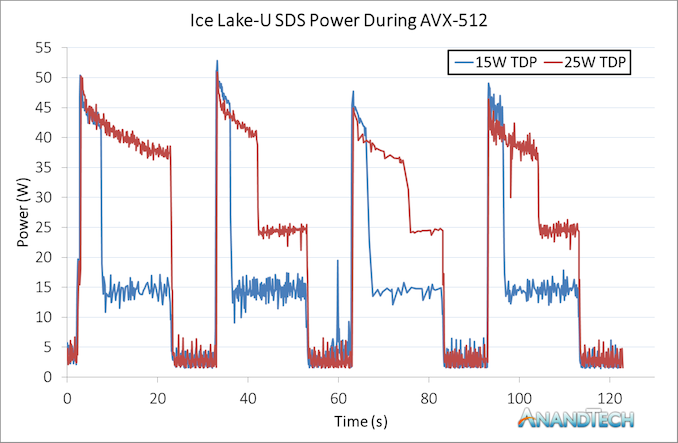The Ice Lake Benchmark Preview: Inside Intel's 10nm
by Dr. Ian Cutress on August 1, 2019 9:00 AM EST- Posted in
- CPUs
- Intel
- GPUs
- 10nm
- Core
- Ice Lake
- Cannon Lake
- Sunny Cove
- 10th Gen Core
Power Results (15W and 25W)
Based on the SKU table, Intel was very keen to point out that all of the Y-series processors for Ice Lake and all the 15W U-series processors have cTDP up modes. This means that OEMs, if they build for it, can take advantage of a higher base power of a processor which leads to longer turbo periods and a higher frequency during sustained performance levels.
While cTDP is a good idea, one of the issues we have with the concept is that Intel’s OEM partners that design the laptops and notebooks for these processors don’t ever advertise or publicise if they’re using a CPU in cTDP up or down mode. I could understand why a vendor might not want to advertise using a down mode, but an up mode means extra performance, and it’s hard to tell from the outside what is going on.
For what it is worth, most users cannot change between these modes anyway. They are baked into the firmware and the operating system. However there are a few systems that do expose this to the user, as I recently found out with my Whiskey Lake-U platform, where the OS power plan has advanced options to set the TDP levels. Very interesting indeed.
Also, for Ice Lake-U, Intel is introducing a feature called Intel Dynamic Tuning 2.0.
We covered this in our architecture disclosure article, but the short and simple of it is that it allows OEMs to implement a system whereby the PL1/TDP of a system can change based on an algorithm over time. So it allows for higher strict turbo, and then adjusts the turbo budget over time.
This feature will be branded under Intel’s Adaptix brand, which covers all these CPU optimizations. However, it should be noted, that this feature is optional for the OEM. It requires the OEM to actually do the work to characterize the thermal profile of the system. We suspect that it will be mostly on premium devices, but as the chips roll out into cheaper systems, this will not be there. Intel is not making this feature standard.
Testing Power
Based on the time available, we weren’t able to do much power testing. What I was able to do was run a power profile during the start of our 3DPM AVX512 test in both 15W and 25W modes for the Core i7-1065G7.
The test here runs for 20 seconds, then rests for 10 seconds. Here are the first four sub-tests, and there are a lot of interesting points to note.
The peak power in these systems is clearly the PL2 mode, which on the Intel SDS platform seems to be around the 50W mode. Given that the functional test system is a bit of a chonk, with a strong thermal profile and the fan on all the time, this is perhaps to be expected. The suggested PL2 for Kaby Lake-R was 44W, so this might indicate a small jump in strategy. Of course, with the Kaby Lake-R designs, we never saw many devices that actually had a PL2 of 44W – most OEMs chose something smaller, like 22W or 35W.
The fact that the CPU can sustain a 50W PL2 means that Intel could easily release Ice Lake into the desktop market at the 35W range. Easy. Please do this Intel.
Second to note is the AVX-512 frequency. Not listed here, but under the 15W mode we saw the AVX-512 frequency around 1.0-1.1 GHz, while at 25W it was around 1.4-1.5 GHz. That’s quite a drop from non AVX-512 code, for sure.
Third, we come to the turbo window. Increasing the base TDP means that the turbo window has more budget to turbo, and we can see that this equates to more than 2x on all the sub-tests. In the 15W mode, on the first test, we blow through the budget within 5 seconds, but on the 25W mode, we can actually turbo all the way through the 20 seconds of the first test. This means that there is still technically budget on the table by the time we start the second test under the 25W mode.
Also, that third test – if you are wondering why that graph looks a little light on the data points compared to the others, it is because the AVX-512 instructions took so much of the time on the CPU, that our power software didn’t get any for itself to update the power values. We still got enough to make a graph, but that just goes to show what hammering the CPU can do.
For the base power consumption, we actually have an issue here with the observer effect. Our polling software is polling too often and spiking up the power a little bit. However, if we take the average power consumption between 25-30 seconds, under 25W this is 2.96W, and under 15W this is 2.87W, which is similar.
For users interested in the score differential between the two:
For 3DPM without AVX instructions, the 15W mode scored 816, and 25W mode scored 1020 (+25%).
For 3DPM with AVX-512, the 15W mode scored 7204, and 25W mode scored 9242 (+28%).












261 Comments
View All Comments
jcc5169 - Thursday, August 1, 2019 - link
It's like a long running Intel advertisement ......Ian Cutress - Thursday, August 1, 2019 - link
How so?jordanclock - Thursday, August 1, 2019 - link
Probably because you provided objective measurements instead of long winded conjecture.peevee - Friday, August 2, 2019 - link
"As for Ice Lake itself, our results lean towards Ice Lake outperforming Whiskey Lake, if only by a small margin."A laptop allowing more than 50W on a U chip and with cooler always running is certainly not representative of the real world performance a user would get from real systems. If Whiskey Lake results were obtained on a real system, then the results are not comparable enough that Ice Lake can actually be slower, especially in real world loads (note the performance on x264 and POV-Ray essentially has not changed).
But at least iGPU has improved nicely.
Samus - Saturday, August 3, 2019 - link
They have dedicated pages to 15w and 25w results. Not sure what you're on about about 'allowing more than 50W...' when they power limited the chip for specific-scenario benchmark results.Spunjji - Monday, August 5, 2019 - link
You may want to re-read that Power Results section - put simply, peevee's point still stands and your response is mistaken. At the 25W limit, the CPU spent more than 20 seconds operating between 50W and 35W before it finally dropped down. It's unlikely that the Coffee / Whiskey devices they tested allowed that sort of behaviour, as without a continuous 100% fan speed the thermals would have spiked and lowered the power limit far sooner. Even with the "power limits" you're talking about in place, the chip still boosts like that, so their benchmark results incorporate that behaviour. for any other company I might feel generously inclined, but Intel have already pulled a fast one multiple times by releasing CPUs that have nominally higher specifications but never reach their performance potential in shipping designs due to thermal constraints.Gondalf - Wednesday, January 8, 2020 - link
Spec suite (the reference) is a pretty loooong bench so the cpu stay at 15W all the time without your 50W. Your comment say a lot about you.yeeeeman - Wednesday, June 17, 2020 - link
Also, we not comparing power efficiency here but rather IPC of each core. And the bottom line is that Sunny Cove core has 5-10% better IPC than Zen 2.CSMR - Sunday, August 4, 2019 - link
There is no evidence that the iGPU has improved. We'd need a comparison against Iris Plus 655 to confirm that. We only know EUs have increased (64 vs 48) but EDRAM was removed.brakdoo - Thursday, August 1, 2019 - link
"First of all, I must say that Intel offering us to test a reference system in advance of a launch is a very good thing indeed"You are being played once again as a marketing tool for the Ice Lake launch. Don't tell me you don't see that.